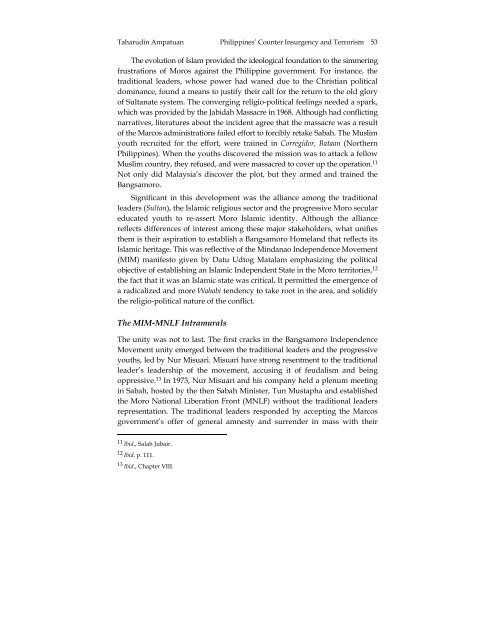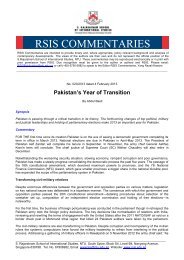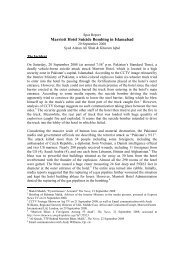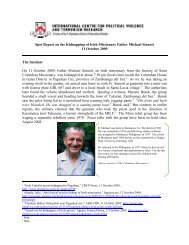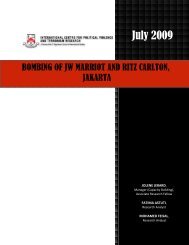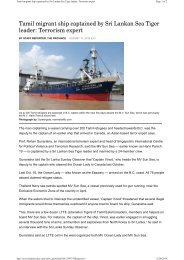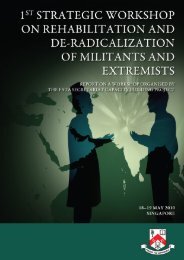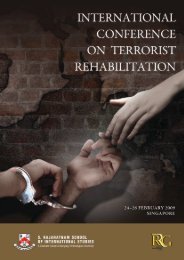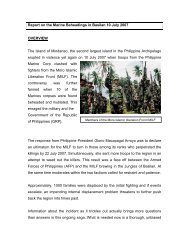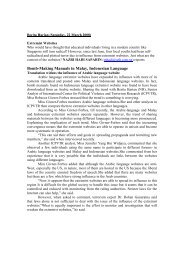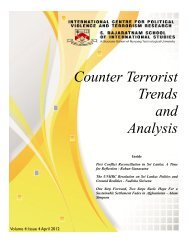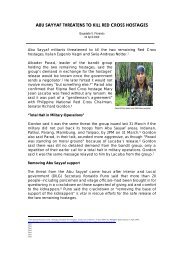Peace and Security Review, Vol.1 No. 2 - International Centre for ...
Peace and Security Review, Vol.1 No. 2 - International Centre for ...
Peace and Security Review, Vol.1 No. 2 - International Centre for ...
You also want an ePaper? Increase the reach of your titles
YUMPU automatically turns print PDFs into web optimized ePapers that Google loves.
Taharudin Ampatuan Philippines’ Counter Insurgency <strong>and</strong> Terrorism 53<br />
The evolution of Islam provided the ideological foundation to the simmering<br />
frustrations of Moros against the Philippine government. For instance, the<br />
traditional leaders, whose power had waned due to the Christian political<br />
dominance, found a means to justify their call <strong>for</strong> the return to the old glory<br />
of Sultanate system. The converging religio-political feelings needed a spark,<br />
which was provided by the Jabidah Massacre in 1968. Although had conflicting<br />
narratives, literatures about the incident agree that the massacre was a result<br />
of the Marcos administrations failed ef<strong>for</strong>t to <strong>for</strong>cibly retake Sabah. The Muslim<br />
youth recruited <strong>for</strong> the ef<strong>for</strong>t, were trained in Corregidor, Bataan (<strong>No</strong>rthern<br />
Philippines). When the youths discovered the mission was to attack a fellow<br />
Muslim country, they refused, <strong>and</strong> were massacred to cover up the operation. 11<br />
<strong>No</strong>t only did Malaysia’s discover the plot, but they armed <strong>and</strong> trained the<br />
Bangsamoro.<br />
Significant in this development was the alliance among the traditional<br />
leaders (Sultan), the Islamic religious sector <strong>and</strong> the progressive Moro secular<br />
educated youth to re-assert Moro Islamic identity. Although the alliance<br />
reflects differences of interest among these major stakeholders, what unifies<br />
them is their aspiration to establish a Bangsamoro Homel<strong>and</strong> that reflects its<br />
Islamic heritage. This was reflective of the Mindanao Independence Movement<br />
(MIM) manifesto given by Datu Udtog Matalam emphasizing the political<br />
objective of establishing an Islamic Independent State in the Moro territories, 12<br />
the fact that it was an Islamic state was critical. It permitted the emergence of<br />
a radicalized <strong>and</strong> more Wahabi tendency to take root in the area, <strong>and</strong> solidify<br />
the religio-political nature of the conflict.<br />
The MIM-MNLF Intramurals<br />
The unity was not to last. The first cracks in the Bangsamoro Independence<br />
Movement unity emerged between the traditional leaders <strong>and</strong> the progressive<br />
youths, led by Nur Misuari. Misuari have strong resentment to the traditional<br />
leader’s leadership of the movement, accusing it of feudalism <strong>and</strong> being<br />
oppressive. 13 In 1973, Nur Misuari <strong>and</strong> his company held a plenum meeting<br />
in Sabah, hosted by the then Sabah Minister, Tun Mustapha <strong>and</strong> established<br />
the Moro National Liberation Front (MNLF) without the traditional leaders<br />
representation. The traditional leaders responded by accepting the Marcos<br />
government’s offer of general amnesty <strong>and</strong> surrender in mass with their<br />
11 Ibid., Salah Jubair.<br />
12 Ibid. p. 111.<br />
13 Ibid., Chapter VIII.<br />
<strong>Vol.1</strong>, <strong>No</strong>.2 2008 pp.49-76


